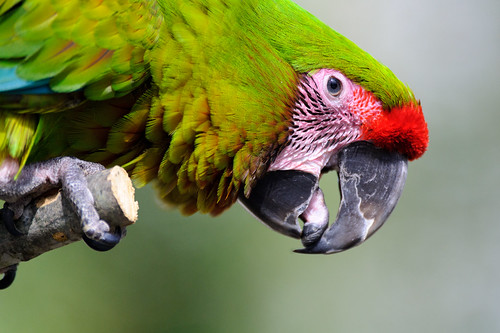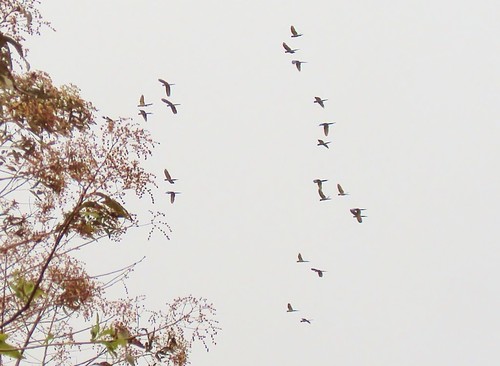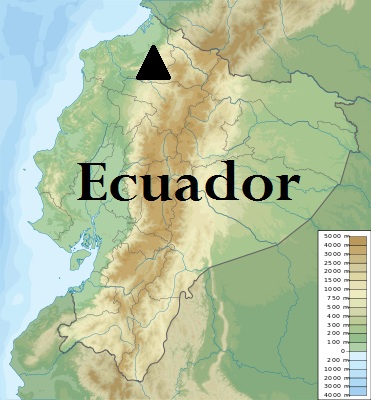 Important population of Great Green Macaws discoverd in Ecuador. Image by Eric Kilby.Forest guards Alcides Zambrano and Jacinto de la Cruz immediately noticed something different when they woke July 22. The nearly constant rain that inundates Ecuador’s Chocó Region, and its noisy patter on their tin roof, was absent. Pleasantly energized by the change in weather, the two set off on a patrol of the Rio Canandé Reserve, where they are employed by WLT-US partner Fundación Jocotoco.
Important population of Great Green Macaws discoverd in Ecuador. Image by Eric Kilby.Forest guards Alcides Zambrano and Jacinto de la Cruz immediately noticed something different when they woke July 22. The nearly constant rain that inundates Ecuador’s Chocó Region, and its noisy patter on their tin roof, was absent. Pleasantly energized by the change in weather, the two set off on a patrol of the Rio Canandé Reserve, where they are employed by WLT-US partner Fundación Jocotoco.
The patrol, which started routinely, took an unforgettable turn when they spotted a large flock of green birds flying nearby at 10 am. Although they recognized the birds - they were Great Green Macaws - the two were astounded by the size of the flock. It was unlike anything they had seen at the reserve. In total, they counted 36 macaws, making it not only the largest flock recorded in Ecuador in modern times, but possibly the largest seen throughout the bird’s entire range.
“The flock spotted by our park guards is an historic record of this species in Ecuador,” confirmed Francisco Sornoza, Director of Conservation for Fundación Jocotoco.  Green Macaw flock of over 36 spotted at Canandé'sThe size of the flock, and the shock it gave scientists and conservationists, can best be measured by the fact that, until now, only 30-40 Great Green Macaws were thought to exist in all of Ecuador. In one brief sighting, Jacinto and Alcides doubled the number of Great Green Macaws known to exist in the country, and filled Jocotoco’s conservation team with encouragement and hope.
Green Macaw flock of over 36 spotted at Canandé'sThe size of the flock, and the shock it gave scientists and conservationists, can best be measured by the fact that, until now, only 30-40 Great Green Macaws were thought to exist in all of Ecuador. In one brief sighting, Jacinto and Alcides doubled the number of Great Green Macaws known to exist in the country, and filled Jocotoco’s conservation team with encouragement and hope.
A large portion of that hope centers on the Canandé Reserve. With much of the species’ habitat in Ecuador destroyed or being destroyed – estimates range up to 90 percent – the Canandé Reserve provides a critical sanctuary for the Great Green Macaw. Thanks in large part to WLT-US donations, the reserve, which provides sanctuary for many endemic Chocó species, grew by 4,285 acres from 2000 to 2008. It currently totals 4,942 acres.
“Jocotoco’s reserves are created with the goal of permanently protecting Ecuador’s threatened bird species,” noted WLT-US President, Dr. Robert Ridgely, a foremost authority on Ecuador’s birds. “This new discovery clearly highlights the importance of the Canandé Reserve to the Great Green Macaw’s continued existence in Ecuador.”
Great Green Macaws, which can measure up to three feet in length, are some of the largest parrots in the world. They are also regarded as one of the most brilliantly colored parrots in the Western Hemisphere, and display a striking combination of lime-green, scarlet, and turquoise plumage.
As Great Green Macaw habitat has disappeared, so have the birds. Once locally common from eastern Honduras to western Ecuador, populations of Great Green Macaw have crashed in recent decades. As a result, it is now an endangered species, with current population estimates of mature individuals totaling less than 2,500. In Ecuador, large swaths of the bird’s habitat, the biologically-rich Chocó Rainforest, have been cleared by oil palm plantations, timber harvests, and other development projects.
Driven on by this spectacular success, Fundación Jocotoco is currently investigating options to purchase several tracts of excellent Great Green Macaw habitat, threatened by potential development, that lie adjacent to the reserve. Location of Canandé Reserve in Ecuador“We’ve been supporting the Canandé Reserve since 2000, and there’s no better evidence that our efforts are working than the recent Great Green Macaw sighting. We’re excited to continue working with Fundación Jocotoco in the future to expand the Canandé Reserve, and build upon this achievement,” said Dr. Paul Salaman, President of WLT-US.
Location of Canandé Reserve in Ecuador“We’ve been supporting the Canandé Reserve since 2000, and there’s no better evidence that our efforts are working than the recent Great Green Macaw sighting. We’re excited to continue working with Fundación Jocotoco in the future to expand the Canandé Reserve, and build upon this achievement,” said Dr. Paul Salaman, President of WLT-US.